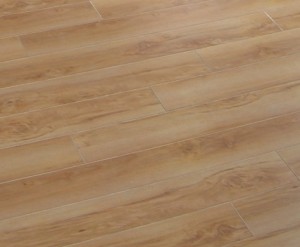Floor Care Primer
Although the process of caring for your floors seems simple, it can quickly become a confusing ocean of claims and counter-claims from commercials and passed down wisdom. At the end of the day, there are only so many different types of floors and only so many ways to treat them.
Wood Floors
Wood is a natural material that expands and contracts throughout the year. It is an absorbent material and is not a uniform color. These factors explain the challenges we face as we try to care for our floors in the best way. Regular, real wood floors are generally waxed or have a Urethane finish. Wax products literally are rubbed into the wood fibers and clog up the surface, providing a sealing layer that can be buffed to a nice shine. Waxed floors should never have water applied to them on purpose. Simple cleaning is done with a dustmop or a Swiffer pad. If there is wet cleaning to be done, we generally recommend Bona’s hardwood floor cleaner. Every three or four months wax should be reapplied to replace what wears away with normal wear and tear. About every year, the entire surface should be stripped and refinished with 2 or 3 coats of fresh wax. Urethane finished floors have a hard topcoat painted on and therefore require only a gentle detergent mopping to return to their best appearance. Oil based urethane sometimes yellows over time; the only way to repair this is through a complete strip and refinish, a difficult and time consuming job. Fortunately, water based urethane has improved dramatically over the past few years and doesn’t suffer this disadvantage. These finishes can last from five to twenty years, depending on wear and environmental factors. One final finish type is the oiled floor. Oiled floors are fairly rare in modern day America and generally require specialized care that is beyond the scope of this article.
Regular, real wood floors are generally waxed or have a Urethane finish. Wax products literally are rubbed into the wood fibers and clog up the surface, providing a sealing layer that can be buffed to a nice shine. Waxed floors should never have water applied to them on purpose. Simple cleaning is done with a dustmop or a Swiffer pad. If there is wet cleaning to be done, we generally recommend Bona’s hardwood floor cleaner. Every three or four months wax should be reapplied to replace what wears away with normal wear and tear. About every year, the entire surface should be stripped and refinished with 2 or 3 coats of fresh wax. Urethane finished floors have a hard topcoat painted on and therefore require only a gentle detergent mopping to return to their best appearance. Oil based urethane sometimes yellows over time; the only way to repair this is through a complete strip and refinish, a difficult and time consuming job. Fortunately, water based urethane has improved dramatically over the past few years and doesn’t suffer this disadvantage. These finishes can last from five to twenty years, depending on wear and environmental factors. One final finish type is the oiled floor. Oiled floors are fairly rare in modern day America and generally require specialized care that is beyond the scope of this article.
Laminate Wood Floors
In the last ten years, manufactured laminate floors have shown a surge in popularity, doubtless due to that material’s easy maintenance and good looks.

The clear finish on these products is applied in factory controlled circumstances and will easily outlast a finish that is painted on a completed floor. Consequently, not much maintenance is required on these floors. We generally recommend Bona’s hard surface product for laminate floors, as it seems to leave absolutely no residue.
Tile Floors
Ceramic tiles actually are hard enough that they can be cleaned with many different products. The tricky part in dealing with a tile floor is the grout between the tiles, rather than the tiles themselves. Floor grout needs to be sealed with a penetrating sealer. This sealer must be applied to clean, dry grout and it must be allowed to cure per instructions. If properly applied, grout sealers can dramatically increase the lifespan of your tile’s grout and the grout’s appearance. We still recommend household bleach over more specific products to remove mildew from grout. Please remember that grout is porous and deep mildew ultimately means that you are going to have to dig out and replace that grout eventually.
Stone Flooring
Flooring made from real stone tiles often requires specialty products to clean and protect. Many general purpose products will etch or stain marble and granite, despite these materials’ reputation for toughness.





